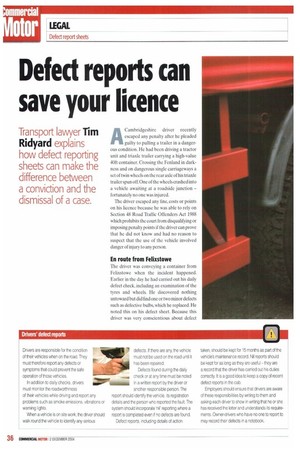Drivers' defect reports
Page 36

If you've noticed an error in this article please click here to report it so we can fix it.
Drivers are responsible for the condition of their vehicles when on the road. They must therefore report any defects or symptoms that could prevent the safe operation of those vehicles.
In addition to daily checks, drivers must monitor the roadworthiness of their vehicles while driving and report any problems such as smoke emissions, vibrations or warning lights.
When a vehicle is on site work, the driver should walk round the vehicle to identify any serious defects. If there are any, the vehicle must not be used on the road until it has been repaired.
Defects found during the daily check or at any time must be noted in a written report by the driver or another responsible person. The report should identify the vehicle, its registration details and the person who reported the fault The system should incorporate 'nil' reporting where a report is completed even if no defects are found.
Defect reports, including details of action taken, should be kept for 15 months as part of the vehicle's maintenance record. Nil reports should be kept for as long as they are useful —they are a record that the driver has carried out his duties correctly It is a good idea to keep a copy of recent defect reports in the cab.
Employers should ensure that drivers are aware of these responsibilities by writing to them and asking each driver to show in writing that he or she has received the letter and understands its requirements. Owner-drivers who have no one to report to may record their defects in a notebook.




















































































































































































